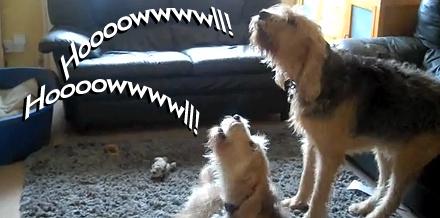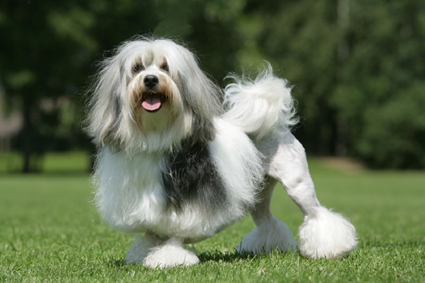Why Dog Carries Food Away: 6 Common Reasons
If you’re constantly stepping on kibble after mealtime, this may be why.
This article was originally published in 2016 and is regularly updated. It was last reviewed for accuracy and updated on February 20, 2025
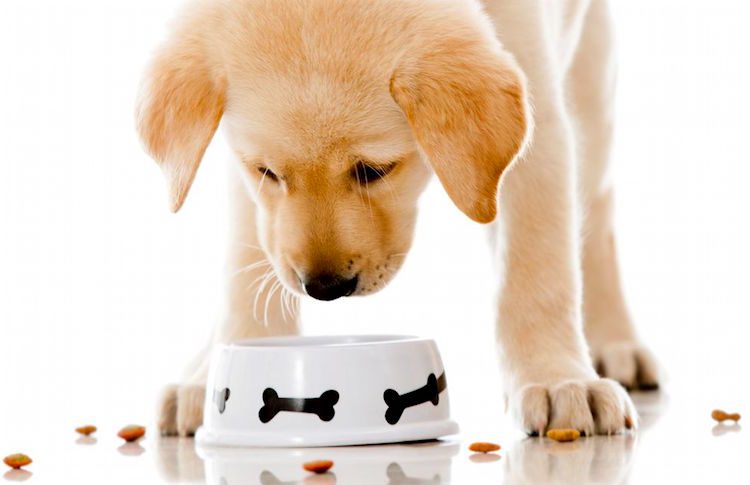
Feeding time is a happy time when you have a dog.
They are usually bouncing off the walls when you’re filling up their food bowl. Most of the time, our dogs dive right in and start eating. But some pups do some pretty strange stuff at feeding time.
Usually when we put food in our dogs’ bowls, they dive right in and start eating. But some dogs do some pretty strange stuff at feeding time.
One behavior that may have you scratching your head is when your dog takes food out of the bowl before eating. They might dump the food on the floor next to their bowl or carry mouthfuls to a different room. Suddenly you have dog food all over your house! What gives?
If your dog does this and you can’t figure out why, keep reading.

Don’t leave your pet’s safety to chance
Sign up for Petful recall alerts today.

What This Behavior Looks Like
Pet parents who notice dogs removing food from their bowl might see it manifest in a variety of ways. These typically include:
- Taking their food to another room in the house.
- Dumping their food bowl on the floor.
- Taking mouthfuls of food out of the bowl and setting it somewhere else before eating.
- Removing food and scattering it in different places.
- Bringing food to a carpet, blanket, or bed to eat.
Even if this behavior is usually harmless, it can make feeding time a challenge for pet parents. Dogs carrying food to another room tend to make a mess that is time consuming to clean up. This behavior can also prolong feeding time or make it difficult for pet parents to track their dog’s food intake.
Getting to the root of why your dog is taking food out of their bowl is the first step in stopping this behavior.
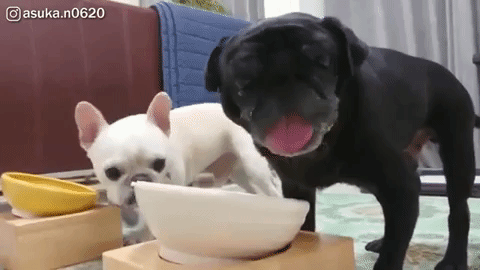
6 Reasons Why Dogs Take Their Food Out of the Bowl
1. Resource Guarding & Natural Instincts
Some dogs, particularly those in multi-dog households, may take food out of their bowl and carry it away as a way to keep it all to themselves.
Before dogs were domesticated, they often ran in packs. The more subordinate pack members would carry food away to hide it from other members of the pack. This is called resource guarding.
“When dogs in the wild make a kill, the outranked animals drag pieces of food away so they don’t have to fight the leader or a more dominant canine for it,” says Dr. Julie Albright-Keck, DVM, DACVB, assistant professor of veterinary behavior at the University of Tennessee College of Veterinary Medicine.
Dogs aren’t looking to start a fight — that would be dangerous. So trying to put the food out of sight is a compromise between giving up their food and fighting for it.
“Rather than stay in the pack and fight for what is theirs, they will snag a piece or two and run away with it,” explains writer Langley Cornwell.“This means they get to eat without the risk of a fight. It also ensures they get some of it without another dog trying to take it away.”
If you have multiple dogs, try feeding them separately to see if that helps.In single-dog households, it may be easier to use a crate or block the exits to the room so your dog can’t carry food elsewhere.
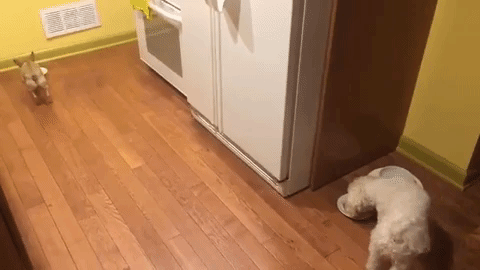
2. Your Dog Doesn’t Want to Eat Alone
Dogs feel loneliness just like people do.
If you’re in another room and your dog is alone in the kitchen, they may carry their food to where you are to eat it.
“Dogs naturally long for companionship, so he may just want to see you or be near you while he eats,” says Cornwell.
Dogs are family members but often don’t eat with the family. Carrying the food to where you are could be a sign that your pet simply wants to be part of the family dynamic.
As a pet sitter, I’ve seen this behavior firsthand. One of my clients simply will not eat if she’s all alone in the room. When I sit for her, I usually set up my laptop nearby or even bring her food bowl outside so we can enjoy the sunshine together.
I’ll sit or stand nearby while she eats. This makes her happy, and she eats right from the bowl
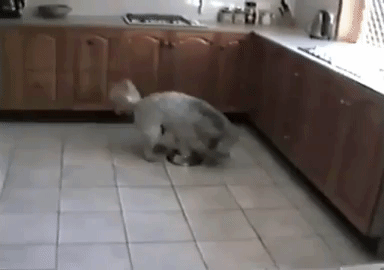
3. Your Dog Doesn’t Like the Bowls
Just like us, dogs have preferences. If your dog is taking their food to another room or removing food from the bowl, they simply might not like the material, size, or shape of the bowl.
If you have metal or glass dog dishes, your dog may be annoyed or frightened by the noise the dishes make when they clang together.Even the sound of their tag hitting the bowl can startle a dog, so they may take the food and carry it away from the source of the noise.
The easy answer to this? Try swapping the bowls for a different material like ceramic, wood, or silicone. A simple change to the material, shape, or size of the bowl might be enough to allow your pup to eat in peace.
Keep in mind that plastic bowls are pretty terrible, so look for a dog bowl that is easy to clean and safe for your pup You could also try putting your dog’s food on paper plates — though, depending on the type of food you feed your dog, this could get messy.
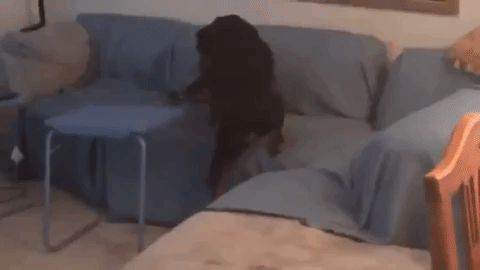
4. Stress or Anxiety
If your dog’s bowl is located in a busy or high-traffic area of the house, your dog may be taking food to another room because they feel stressed or anxious. This could be their way of escaping a busy kitchen or hallway area and trying to eat in a quiet location away from noise and commotion.
Observe your dog for signs of stress around feeding time. This could include shaking, tucking their tail, yawning, or licking their lips repeatedly.
If you feel like stress may be the reason for your dog taking food out of their bow, try moving your dog’s feeding area to a quieter location in the house that they enjoy and frequently visit.
5. Discomfort While Eating
If you notice your dog dumping their food on the ground, moving it to a carpeted area, or bringing it to a different room, it may be due to discomfort. There are a variety of things that could be making your dog uncomfortable with their current food setup.
First, if your dog’s bowls are located on a hard surface — like a tile or hardwood floor — your dog may not like it. Hard floors may cause aging dogs or pets with joint issues to slip or slide, putting more strain on their bodies. That’s why some dogs may move food over to a carpeted area or their beds to eat.
Depending on your dog’s height, age, and health condition, bending down to eat food out of the bowl may also cause strain. You can try raising your dog’s food bowl to help them access the food more easily.
While rare, it is also possible for dogs to experience whisker fatigue while eating. This is when a dog’s whiskers repeatedly brush against objects (like the side of a food bowl) and it causes discomfort or stress. If you believe this is the reason your dog dumps their bowl or moves food to a different area, try feeding from a larger bowl or a flat plate to prevent their whiskers from rubbing.
6. Your Dog Is Creating a Personal Stash of Food
When in the wild, dogs or wolves would often drag the remaining prey away and hide it somewhere. Your dog could be doing the same thing.
In their book How Dogs Work, Raymond Coppinger and Mark Feinstein explain that dogs “sometimes store food that they have foraged by digging a ‘cache’ and hiding it away for future consumption.”
If you stumble across dog food in random places, your dog may be “caching” some of the food. The solution, again, is simple: Make sure you’re not overfeeding your dog, and then block off the exits to the room they normally eat in.
If your dog is carrying food away, it may be because of one of the above reasons — or something else could be at play. As always, check with your veterinarian if you’re concerned.
Should You Be Worried About A Dog Moving Their Food?
Most of the time, a dog taking food or treats to another room or area of the house is harmless. You can chalk it up to another weird dog behavior that we don’t fully understand. Like humans, some dogs simply have preferences. Where and how they eat might be one of them.
However, this habit can be messy and make cleaning more difficult. This is especially challenging if you have other pets around the house that might eat the food or if you have human babies or children that see dog food as a special snack. If you want to prevent food-carrying behavior to make cleanup easier, try gating your dog in a specific area or room during mealtimes. You can also try feeding your dog in their crate, since most pups view their crate as a safe space.
If your dog is showing any other signs of aggression (like growling, teeth baring, or snapping) or stress along with food-carrying behavior, it’s important to consult a veterinarian or a certified animal behaviorist or dog trainer. They can help you and your family work through any problematic resource guarding or help identify stress triggers that could be impacting your dog.
Tips to Manage Your Dog’s Food-Carrying Behavior
- Feed in a Quiet Space: Provide a calm, quiet environment for your dog to eat without distractions or competition.
- Separate Feeding Areas for Multiple Dogs: Feed dogs in separate areas to prevent competition and protectiveness over food.
- Use Different Bowls: Try using non-metal bowls if noise is an issue; consider plastic or ceramic alternatives.
- Stay Nearby During Meals: Stay close to your dog while they eat to provide companionship and reduce loneliness.
- Monitor and Adjust Portions: Ensure you are not overfeeding your dog to reduce the need for storing food.
Frequently Asked Questions (FAQ)
Why do dogs take food from the bowl and eat elsewhere?
Dogs may take food from their bowl and eat elsewhere to protect it from perceived threats or to be closer to their owner.
Why does my dog drop his food on the floor before he eats it
Dogs might drop their food on the floor before eating it due to discomfort with their bowl or to examine it more closely.
Why do dogs take their food to another room
Dogs take their food to another room to eat in a quieter or more comfortable location or to be near their human companions.





